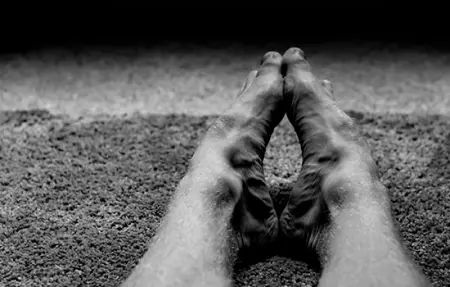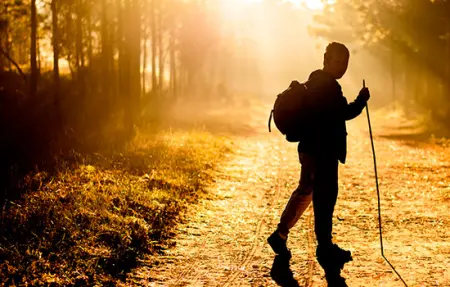YOU need to be in shape to do the journey, although it depends on many factors, such as the route you choose, your age and your physical condition, among others. The Camino de Santiago is still a pilgrimage route that requires both physical and mental training.
.
» Physical preparation to do the Camino on foot
The Camino of Santiago is a route that can be very long and tedious. There are really long routes, which pass through corners of complex orography, so you have to be prepared. If you are going to do the Camino de Santiago, we strongly recommend you to be ready for it in advance.
In addition, you must bear in mind that you should prepare yourself according to your own physical conditions, and that it is a type of exercise with very specific needs. Even if you are an expert runner or swimmer, for example, your body may not be used to these long walking sessions. That is why it is best to prepare a training session in the months prior to the Camino so that your experience can be the best.
And remember that some Ways will be easier to walk than others due to several factors. The slopes, the distance between stages, as well as the services that we will find between them are elements that you should evaluate before starting your adventure. Choose the Camino de Santiago that is more suitable to your physical level so that you do not have any type of problem. This way your pilgrimage can become a truly unique and unforgettable experience.
Before the Camino
In order to get used to the stages that await you along the Camino, it is best to start your training in the previous weeks, walking a few kilometers a day and progressively increasing the distances little by little.
It is important that during this previous training for the Camino de Santiago you walk over all types of surfaces, since it will be what you will find during your pilgrimage. The ideal is to alternate between asphalt and dirt roads, as well as trying to face unevenness and slopes as much as possible. And if you can do these tours with a backpack, all the better. This way you get used to walking carrying a little weight on your back.
Our last tip, although it may be the most important in this previous phase, is that you pay attention to your footwear. Try using the same boots or sneakers that you are going to take to do the Way of Saint James, especially if they are brand new. You should never use them for the first time the same day you start your pilgrimage because they will cause you chafing and blisters that you will have to endure during all the following stages. That is why it is best to shape the footwear little by little during the preparation before the Camino.
During the Camino
Warming up and stretching your muscles before starting each daily stage is perfect to avoid unexpected pulls and injuries. Pay special attention to your lower body muscles, stretching your calves, quads, and hamstrings well. It is best to start at a gentle pace allowing the muscles to warm up and then gradually build up.
In any case, it is important that you always continue at your own pace, maintaining a comfortable pace at all times adapted to the terrain you are walking. Make stops every two hours approximately to rest for a few minutes, during which time you should try to hydrate yourself well, especially if you do the Camino during the summer season and in the sun.
On the other hand, remember to carry plasters and vaseline in your backpack, as well as a needle and thread for the blisters that may arise between stages. Smearing your feet with vaseline will help you avoid chafing with your footwear, while the plasters will protect the areas where they have already appeared. The needle and thread will serve to puncture the blisters when you have reached the end of each stage, letting the thread absorb and expel the liquid overnight so they will have disappeared the next morning.
After the Camino
After the Camino and after having received our Compostela as a prize, surely we will forget about the accumulated fatigue, the stiffness and the possible blisters on our feet. At least for a time, with the illusion of having reached Santiago and having fulfilled our goal.
Many experts recommend taking a short walk the next day calmly to allow the muscles to be properly irrigated. You must not forget to clean well and pamper your feet so that they recover little by little. If you need it, near the cathedral you can find podiatry clinics and massage therapists always available to pilgrims.
Our last recommendation is that you drink a lot of water in the following days to recover fluids. And if you can do it while enjoying the best Galician gastronomy to regain strength, all the better. Visit the Mercado de Abastos located very close to the Cathedral to get the freshest products or taste the best dishes in one of the local terraces that you will find in the historic center.
» Mental preparation to do the Camino de Santiago
In addition to some previous physical preparation, walking the Camino de Santiago also requires some mental preparation. This is a multi-day tour, so your endurance will be tested in all aspects.
To avoid exhausting yourself mentally and not be obsessed over the end goal, you should try to make the most of this experience and enjoy every step. The Camino de Santiago gives you the opportunity to connect with nature and a unique environment. But, above all, to connect with yourself.
Therefore, in addition to planning the stages realistically and according to your limitations, it is also important that you take time to relax and clear your mind. In this way, you will be able to cope with the whole process much better without becoming overwhelmed by your circumstances.
Plan your times, distances and breaks
Before starting the Camino, it is important to have at least some mental planning about the time you are going to dedicate to this and the distance you will travel each day, always taking into account your physical condition. Remember that although the stages are usually delimited, you don't have to follow them strictly: walk fewer kilometers a day if you need to and organize your route your way.
And just as you think about physical effort, do not forget to also calculate the times you will dedicate to rest and sleep, in addition to stop every now and then to appreciate what you will find in each stage.
Our recommendation is that you focus on your daily goal, without obsessing over getting to Santiago de Compostela. Walk each day at your own pace and take notice of the elements around you. Enjoy that well-deserved rest once you have reached the end of your stage and regain strength to face the stage that awaits you the next day.
A long road awaits you, so nothing better than thinking about the moment and enjoying every step.
Enjoy nature and the environment
One of the best things about the Camino de Santiago is that it allows us to be in contact with nature at almost all times, while we walk through dirt paths, forests, and among the purest vegetation. Therefore, it is practically mandatory to know how to take advantage of these places to breathe fresh air and disconnect. It goes without saying that this brings benefits not only physically, but also mentally and even spiritually.
Especially if you live in the city, you will know how to value this quiet and peaceful environment like no one else. If you also opt for a Camino with little influx of pilgrims, you may travel certain sections completely alone. There cannot be a better opportunity to connect with yourself! And if we are doing the Camino as a couple or in a group, this experience will help us to get to know each other better, sharing valuable time with them without other distractions.
There will also be stages in which you visit towns and rural areas, or larger towns that you may now see with different eyes if you have already visited them before. As a pilgrim, you will see that even the welcome by those people in those places is different, so value it and take advantage of the good atmosphere and hospitality that its inhabitants will offer you, without losing the opportunity to soak up in their history and traditions.



